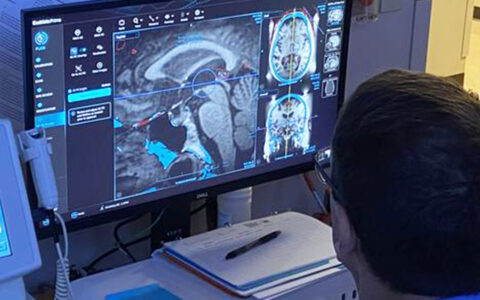Josh Greensweig, D.P.T., a physical therapist at Vanderbilt University Medical Center, is developing a novel program to bring osteoarthritis (OA) education and treatment to Metro Nashville Public Schools (MNPS) employees. The program is based on research and proven models of weight loss and strength training. Exercise and a healthy weight are prime determinants in preventing and managing OA.
Last July, Greensweig approached MNPS with his proposal to provide an intensive OA education and treatment program at their wellness center, which opened in 2017. Teachers have a high incidence of OA and metabolic disorders, Greensweig said. “Teachers move around a lot during the day, but their activity is too low an intensity to confer health benefits. We hope we have some persuasive arguments for making the trip to the wellness center and integrating good eating habits into their day.”
The findings of the Intensive Diet and Exercise for Arthritis trial were a powerful motivator for Greensweig. “Those researchers worked with 454 overweight and obese adults with OA and found clear evidence that intensive weight loss through diet and exercise had both anti-inflammatory and biomechanical benefits.”
A Novel Initiative in the U.S.
Osteoarthritis affects 25 to 40 percent of American adults. Sharing root causes with metabolic conditions and heart disease, OA still lacks the clinical focus and incentives needed to move the needle, Greensweig says, particularly under fee-for-service models.
The physical therapy component of Greensweig’s program draws heavily from the Good Life with osteoArthritis in Denmark (GLA:D) model, which has now expanded to Australia, Canada, China and Switzerland. Nearly 40,000 Danish citizens have participated in GLA:D’s exercise and weight loss initiative, dropping their knee and hip pain intensity 23 and 27 percent, respectively. GLA:D participants also report significant improvements in physical function and quality of life, and fewer pain medications.
Greensweig says the unique features of school work call for different motivators and strategies. “Where GLA:D focuses primarily on the exercise component, our program needs to also focus heavily on diet and weight management,” he said.
Program Structure and Goals
Individualized weight loss plans for MNPS participants will target a three- to six-month weight loss goal of at least eight percent, enough to see clinically important effects. The program will first educate groups of four to eight participants on the etiology and physiology of OA, debunk myths, and review guidelines for exercise, diet, weight management and sleep.
Six to eight weeks of structured exercises follow the education component. “Changing the muscle quality is primary in improving OA symptoms. If we do that, we can impact the pro-inflammatory cycle that contributes to cartilage depletion and pain,” Greensweig said.
“These MNPS employees have an opportunity to achieve unprecedented success.”
“These MNPS employees have an opportunity to achieve unprecedented success,” said Leon Scott, M.D., assistant professor in the Department of Orthopaedic Surgery at Vanderbilt, who consulted with Greensweig on the project. “Across professional medical societies, the only consistent treatment recommendations for osteoarthritis are weight loss for overweight to obese individuals and strengthening with resistance exercise.”
Bigger Objectives
One of Greensweig’s objectives is to change perceptions that imaging is always necessary or predictive of pain and functionality. “In many cases, our clinical exam will provide an accurate working diagnosis of OA, without an MRI or X-ray,” he said. By cutting down on imaging referrals, Greensweig expects that the program will help achieve cost savings and instead expedite referrals to therapy.
“If arthritis is a root cause for metabolic syndrome, heart disease and many mental health problems, exercise and weight management are root solutions.”
Providing more evidence supporting preventative and palliative OA care in an insurance climate designed to be reactive is one of Greensweig’s most challenging goals. “Arthritis is usually a preventable disease if we can address those risk factors upstream. If arthritis is a root cause for metabolic syndrome, heart disease and many mental health problems, exercise and weight management are root solutions.”






